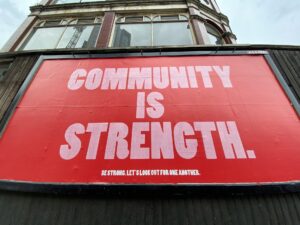Egypt – Community Participation In Low Income Housing
| Download Document | |
| Document Type: | General |
| Publish Date: | 1987 |
| Primary Author: | Mohamed Abdelbaki Mohamed Ibrahim |
| Edited By: | Tabassum Rahmani |
| Published By: | www.cpas-egypt.com |
Introduction:
This study aims to achieve the most effective community participation in solving the housing problems of low-income groups in Egypt. The study refers to some approaches of community participation and reviews both the international and the Egyptian experience, respectively. The study concentrates on the ways and means recommended to increase the role of community participation in solving the problem of low income housing. Stress is laid on the question of training programs and the search for appropriate building technology.

The housing problem in Egypt is affected by socioeconomic and physical factors. These factors are integrated to different degrees and on different levels. The socioeconomic factors reflect the role of community participation in the problem. The role of the community has been restricted by a number of rules and regulations which limited its participation in solving part of the problem, especially for the low-income groups. For this reason, low-income groups tried to solve their problems by building their informal housing by their own means regardless of any rules or regulations in order to satisfy their own needs.
What Is Community Participation?
Community participation as a process can be defined as active and meaningful involvement of the masses of people at different levels of development. The participation could be active in the decision making process for the determination of social goals and the allocation of resources to be achieved. It also would be expressed in the voluntary execution of resulting programmers and projects.
Approaches to community Participation:
The meaning of community participation varies according to the different approaches reflecting the point of view of those involved in this operation and their socio-economic background. Referring to R. Skinner, community participation, from the national point of view, can be both a potential threat to the established power and a means of presenting a popular approach to the problem of the poor.

From the implementation agencies point of view, community participation may be a way of making a project acceptable to the local population, as it will be cheaper and smoother to implement. From the residents point of view it means a role in the development of their environment where they can choose the improvement option, and reduce the project costs.
Ways and Forms of community participation:
There are many ways and forms of community participation in developing their own environment or in improving their living condition. These forms of community participation could be classified and identified separately. There are almost ten forms of community participation which could be categorized into similar groups of activities, according to White classified form. These ten forms are:
-
consultation
-
financial contribution
-
self-help of beneficiaries
-
self-help by whole community
-
specialized workers
-
mass action
-
collective behavior
-
endogenous development
-
autonomous projects
-
self-sufficiency
Consultation:
Prior to consultation, there is a need to study the social and cultural structure of the community. This is carried out usually by the local authorities. It is preferable to get this information from the community members themselves, because they are familiar with their own situation.
Financial contribution:
This is a cash collection made by and within the community, generally prior to, or at, the time of implementation of a project as a contribution to carry out the constructions work.
Self-help projects by Groups of Beneficiaries:
This form of community participation is carried out by specific groups of local inhabitants who contribute with their labour and perhaps other inputs in the implementation of a project with the assistance of an external development agency. In this case the participation of the whole community is more appropriate than a special group of beneficiaries since all community members are going to use the project services.
Self-help projects Involving the Whole Community:
This form of community participation is done by all the families in the community. They contribute to the project as labour or in other form of input with the assistance of an external development agency. This kind of involvement needs to be based on an agreement between community representatives and the project developing agency.
Community special Workers:
This form of community participation is achieved through training and appointment of one or a few community members to perform specialized tasks. The training and technical supervision are carried out by an external development agency.
Mass Action:
This form of community participation is achieved by the collective work of the community members without a major input from an outside development agency. Often such actions are directed to environmental improvement. In this form the organized community basically carries out the activities rather than merely contributes to it. It is the whole community which carries out the work as a collective effort rather than either a group of beneficiaries or a local authority.
Collective Commitment to Behavior Change:
This form of community participation is performed when the community makes a collective decision to change customs or personal habits. In this case collective social pressure is exercised for the realization of such change. As White puts it “community participation is involved when an explicit decision is collectively taken”.
Endogenous Development:
This form of community participation is achieved when there is an autonomous generation of ideas and movements within the community for the improvement of living conditions.
Autonomous Community Project:
This form of community participation is found in projects where any external resources are paid for by the community with funds raised internally, including the hiring of any outside expertise or professional staff. Such projects become therefore under the community control.
Approaches to self-sufficiency:
This form of community participation could be achieved through projects in which the objective is to satisfy local needs as far as possible by using local materials and manpower directly and not by depending on goods and services from outside or buying them after collecting funds. This approach to self-sufficiency is generally a cheap one and puts less burden on the national economy including the transport system. Moreover, it makes use of indigenous knowledge and useful skills which might otherwise be lost.
Community Participation in Management:
The experiment of Lusaka Squatter Upgrading is seen and accepted as a social and an economic experience. The application of the policy of Squatter Upgrading can be a sensitive issue. It requires a careful approach. In the Lusaka Squatter Upgrading project planners and social workers agreed on the importance of local involvement. In one of the official documents on the subject, the Zambia National Housing Authority had this to say, “That there was a need for the “division” of responsibility between the community and authority in the upgrading exercise.
Community Participation in Implementation:
In Lusaka Squatter Upgrading project residents could participate in project implementation by means of ongoing self-help and mutual help improvements, at three levels of organization, on an individual, group and community basis.
Individual basis:
The project aimed to ensure affordable improved housing by encouraging participants to use their own labour and financial resources to construct or improve houses and by providing any assistance necessary to mobilize these individual resources.
Group basis:
Households identified for resettlement in the over spill areas included those whose former houses had been affected by infrastructure installation, and who were to be resettled in Order to reduce densities in the existing upgraded areas or who were tenants who had been allocated on over spill plot, in order to give them an opportunity to build their own houses.
Community basis:
Mutual help projects in which participation took place on a community basis have taken two major forms. The first of these instances is where, as provided for in the original project proposals, mutual help labour has been utilized to undertake the unskilled aspects of a contractor’s work, namely trench digging for the installation of water pipes.
Community Participation in project Maintenance:
It was intended that the Lusaka City Council Engineering Department would take over the responsibility for maintenance of infrastructure but the delay in providing necessary staff and equipment, together with administrative problems have resulted in a great demand for maintenance over the capacity of the engineering department. It has, therefore, been necessary at times to organize maintenance on a community basis. However, the Party appears, understandably, unwilling to put its administrative energies into a task for which the city council is clearly responsible.
Conclusion:
It is obvious from the Egyptian experience in community participation in housing that low-income groups have the initiation and the ability to participate physically or financially because they possess the inherited values of cooperation and mutual help, but they just need to be more organized, and more conscious to know how to manage and implement their houses. This could be achieved through a national program for community participation in low-cost housing according to an intensive community training modules aiming to facilitate and increase community participation.
